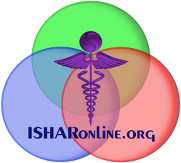Biofield > Noncontact Healing > Reiki
List ISHAR Online Sources: Biofield > Noncontact Healing > Reiki
Functional Summary
|
Modality |
|
By placing hand over or on the body, practitioners channel universal energy for healing. |
|
Intention |
|
Used for decrease of pain and muscle tension, to expedite healing, and improve sleep. |
|
Geo-Cultural |
|
Created by Buddhist Mikao Usui, in 1922. |
Topic Summary
Reiki was developed as a complementary health practice by Usui Mikao in 1922, with its foundation in the belief that energy supports a body’s natural ability to heal. Usui also developed five commandments or concepts based on writings by the Emperor Meiji about how practitioners could live happier lives. These concepts are: do not be angry, do not worry, be grateful, work with diligence, and be kind to people. Practitioners believe Reiki works by placing their hands over or on the body, then channeling the flow of spiritual energy into the receiver of treatment. The energy then enhances the body’s innate healing power.
In addition to the Japanese tradition, a system of Western Reiki was developed by Hawayo Takata, a Japanese-American from Hawaii. Many of the practices of Western Reiki are similar to the traditional Japanese style, but with modifications to make them more acceptable in the West, including a claimed Christian history.
Research Summary
Numerous studies have been done on the effectiveness of Reiki, however the research which has been conducted has shown a variety of results. A pilot study published in 1995 saw a significant reduction in pain in its subjects following Reiki treatment. A later study published in 2015 looked at Reiki’s ability to help specifically with depression and anxiety and concluded that there was insufficient evidence to prove that it helped with either. However, another study the same year examined effects of Reiki therapy on improvements in quality of life, mood, and symptom distress during chemotherapy, and found that it was a feasible and acceptable means of potentially reducing side-effects. Additional research continues to be conducted to determine this complementary treatment’s efficacy.
Perspectives
ISHAR strives to present all of our data in an impartial, informative manner. Nonetheless, there are always different viewpoints on various topics, and ISHAR encourages users to review the perspectives on other informational sites, then come to their own conclusions regarding what they consider the least biased. The sites below were chosen to represent a wide spectrum of approaches to this topic, and none are endorsed or promoted by ISHAR itself.
- Wikipedia: http://en.wikipedia.org/wiki/Reiki
- WebMD: http://www.webmd.com/pain-management/tc/reiki-topic-overview
- Pro-Practice Website: http://www.manitouwellness.com/what-we-do/7-health-benefits-of-reiki/
- Anti-Practice Website: https://www.sciencebasedmedicine.org/reiki-fraudulent-misrepresentation/
